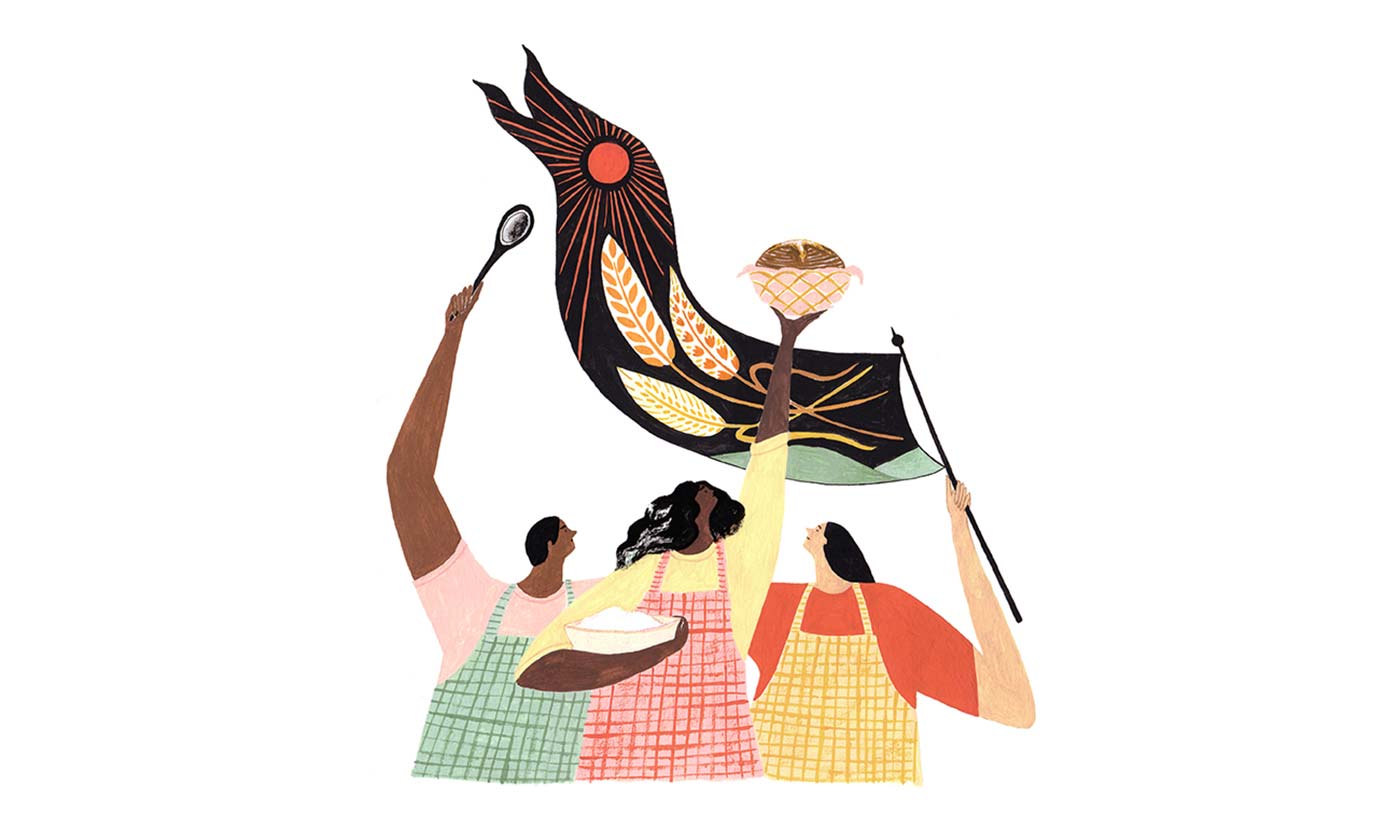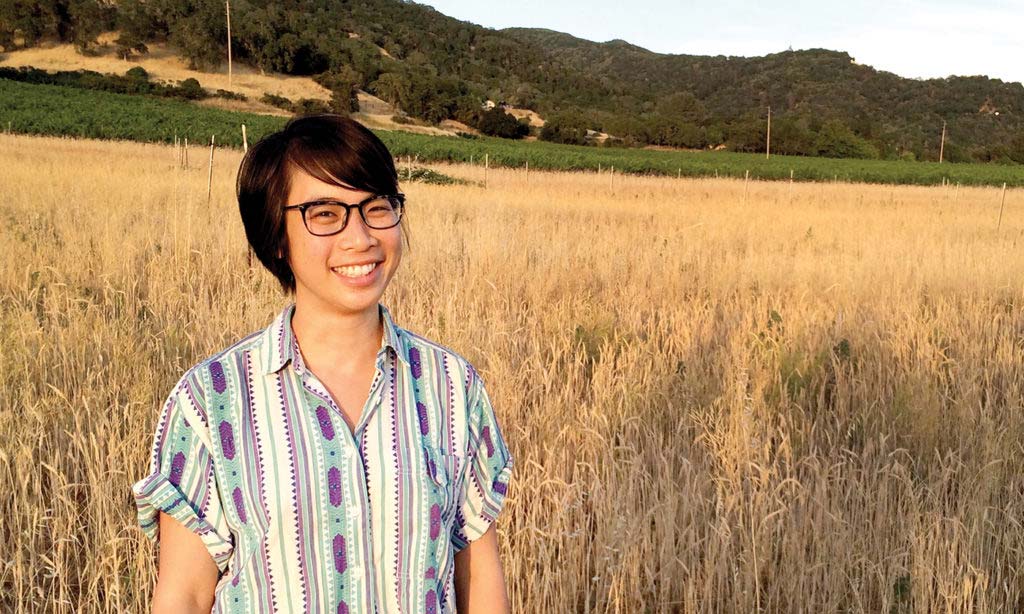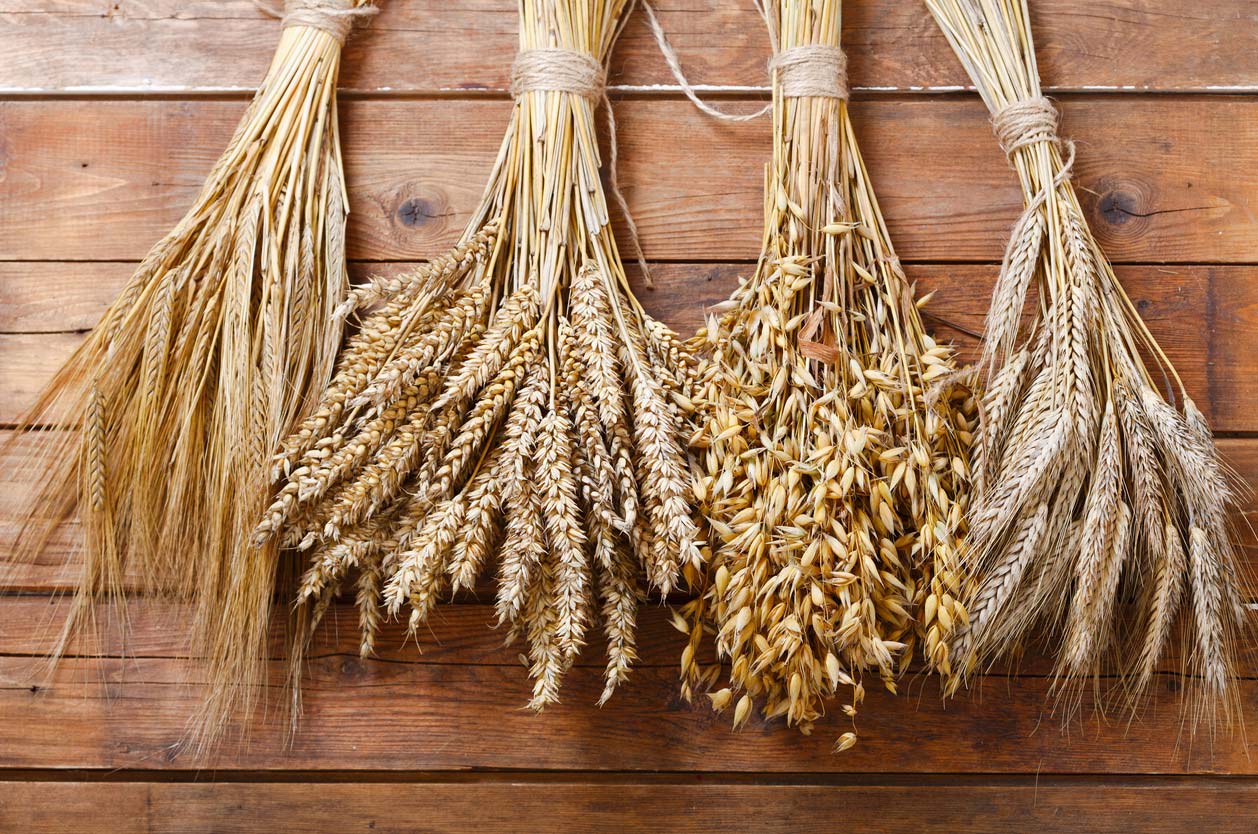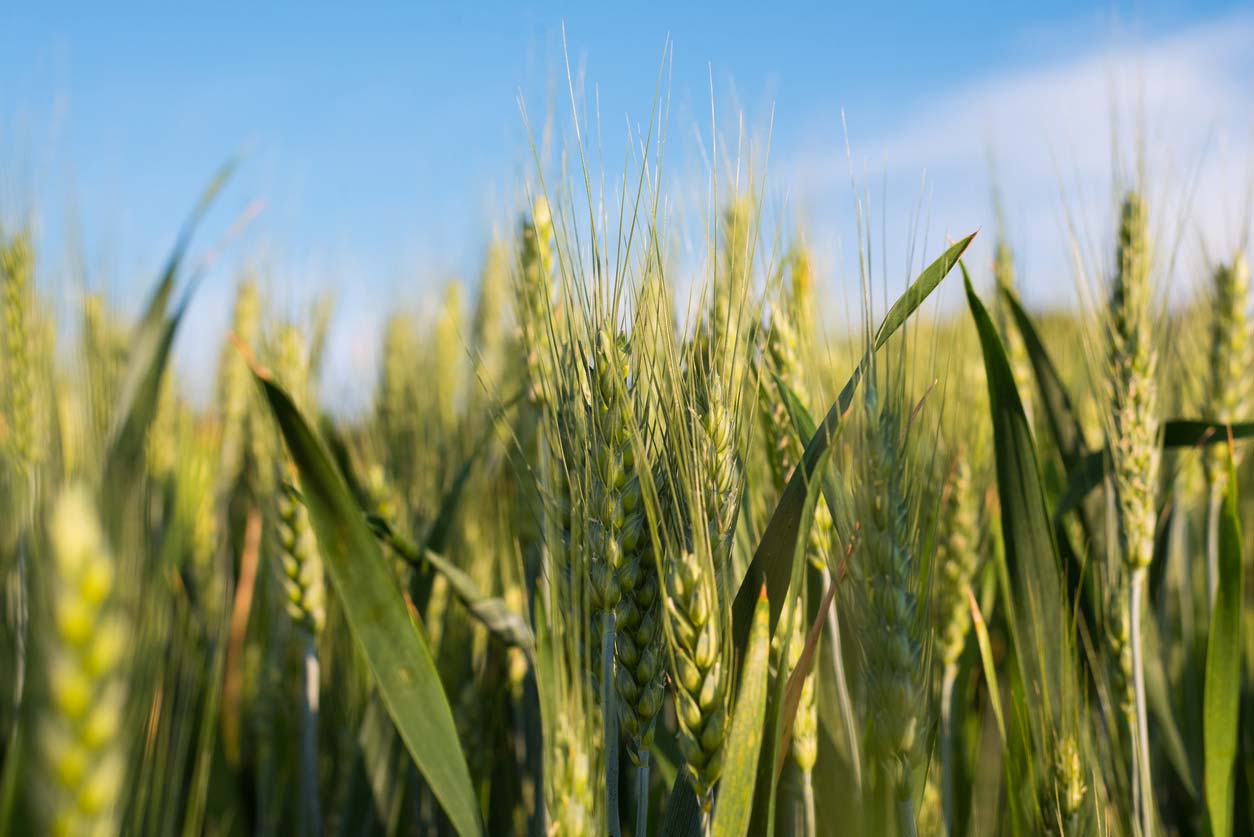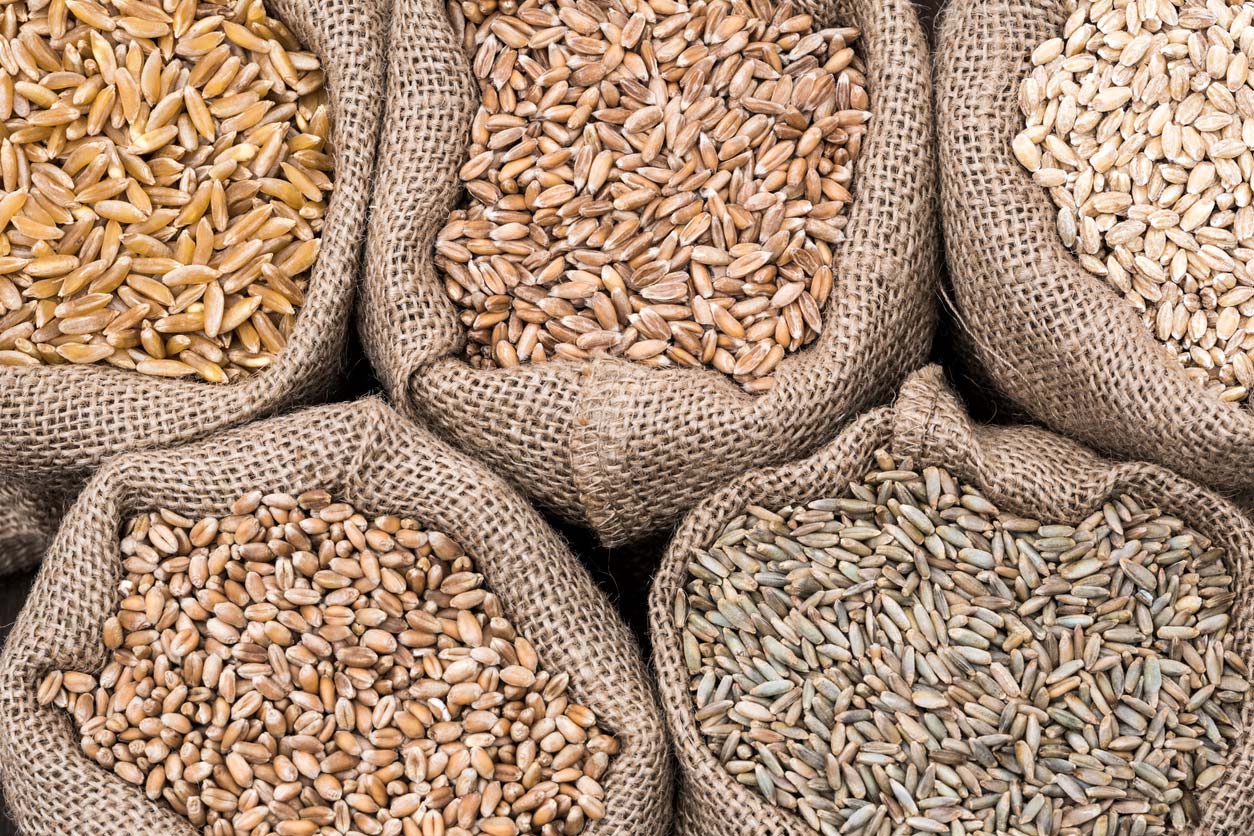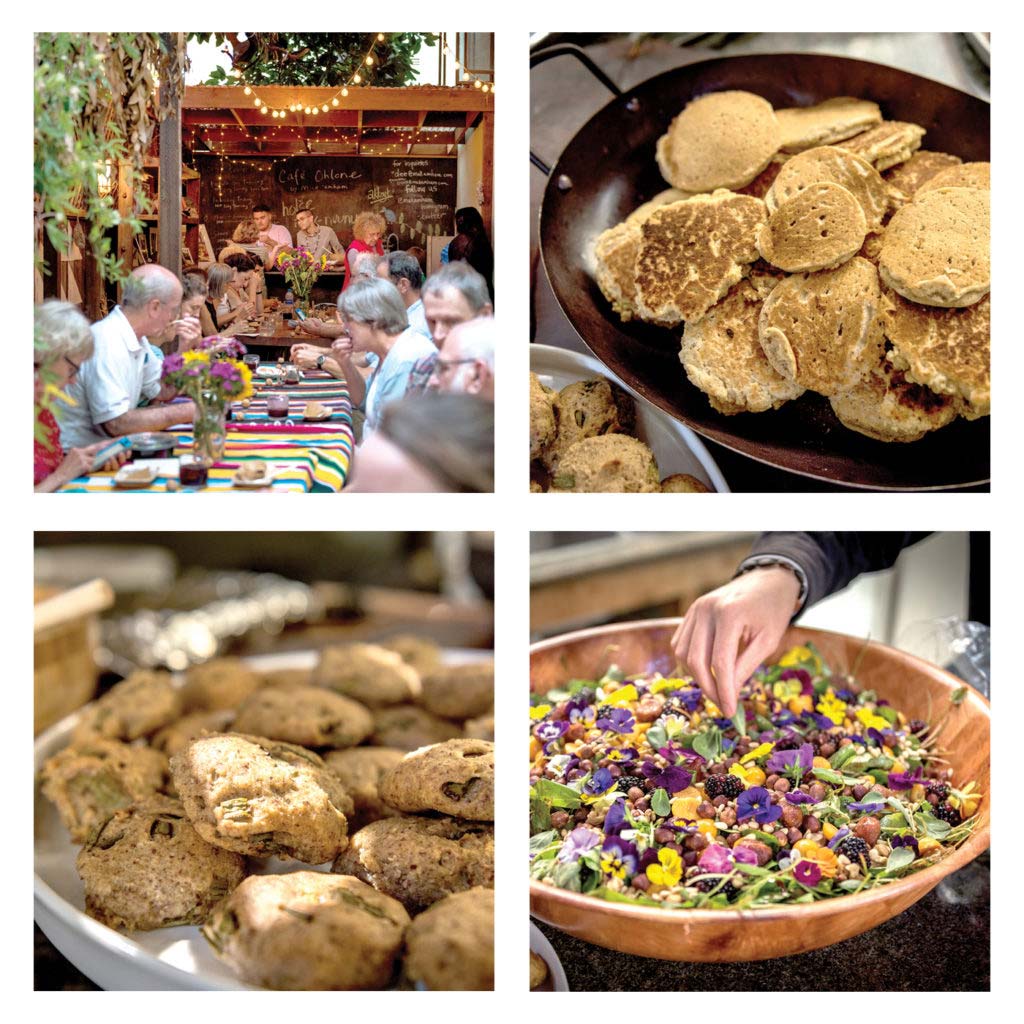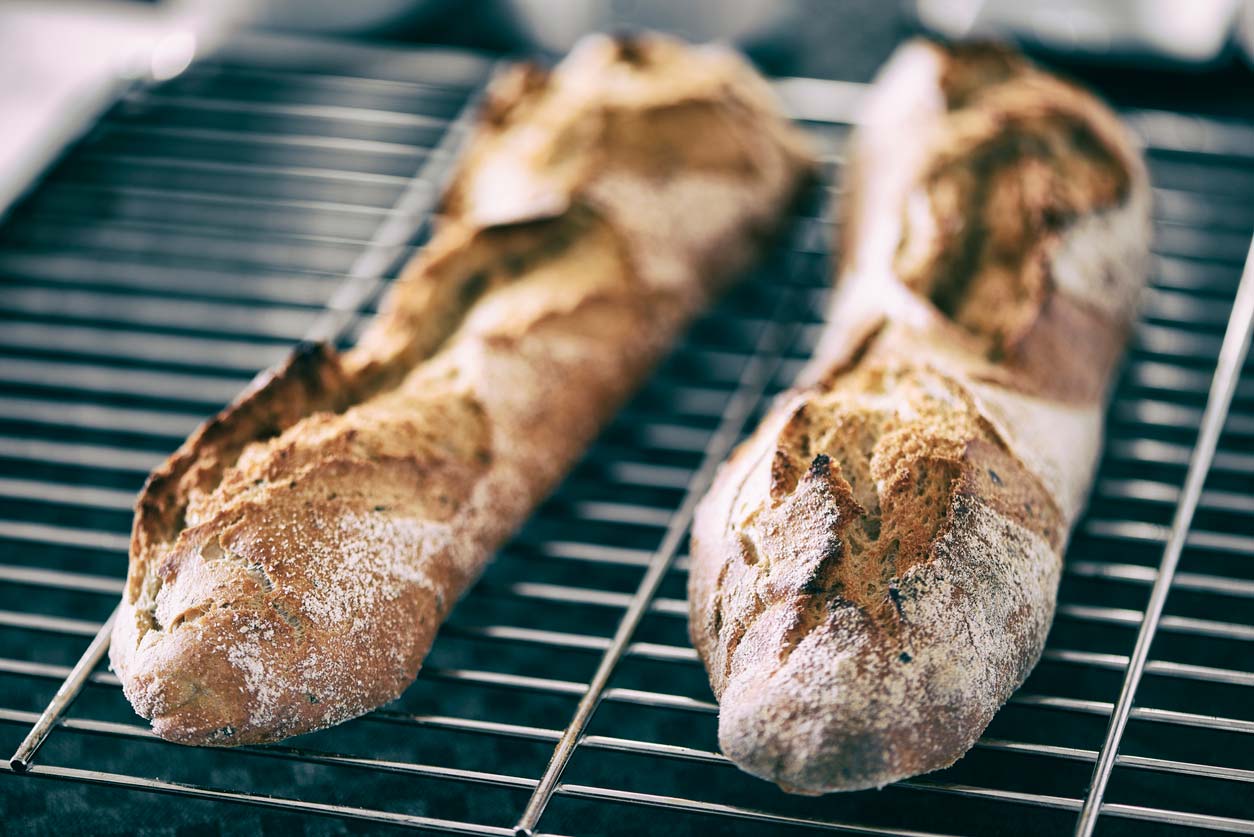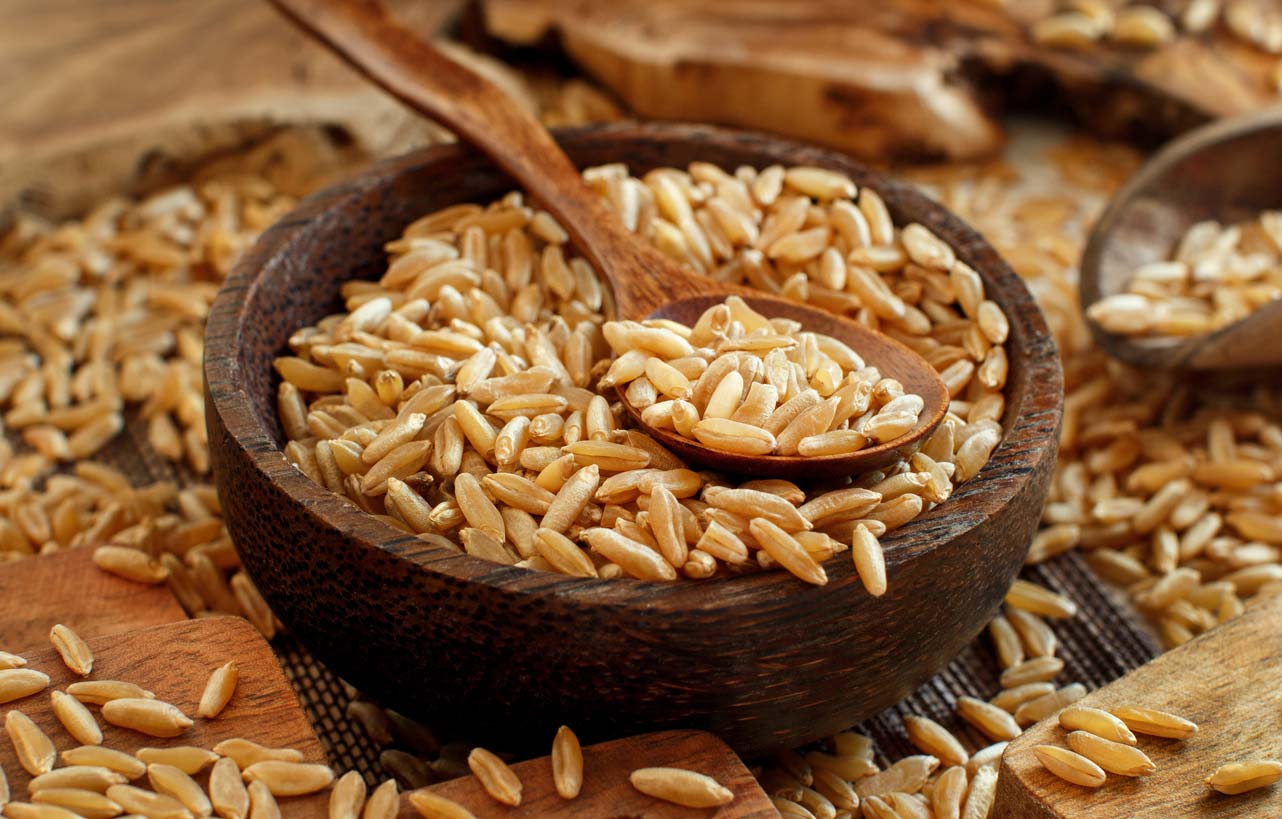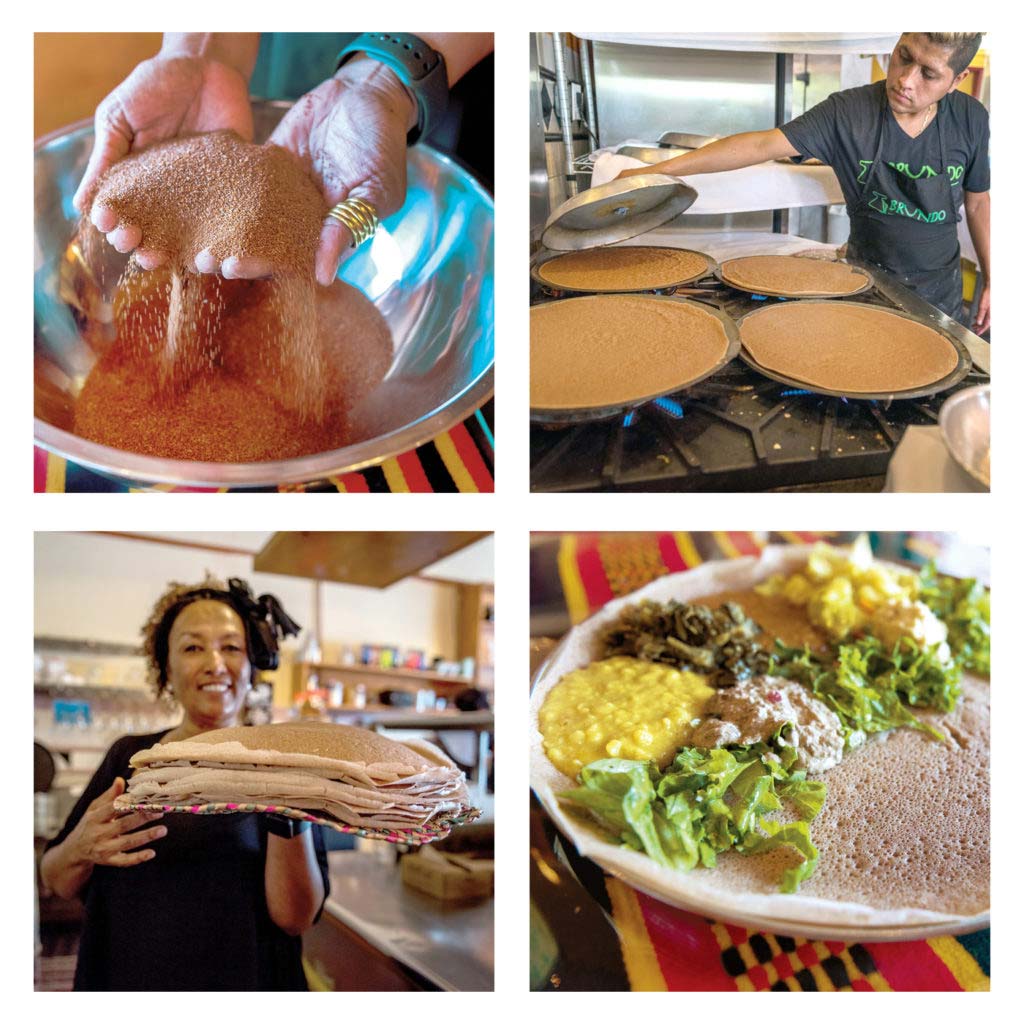By Liz Carlisle • This article originally appeared in YES! Magazine
In 2010, committed locavore Mai Nguyen experienced a hard winter for the first time. A Californian temporarily living in Canada, Nguyen scoured nearby markets for a local, seasonal treat to break up the monotony of cabbage and potatoes. “I was surprised to find that there were all these different varieties of whole wheat,” Nguyen recalls. “Red Fife. Marquis. In the midst of winter, I was so grateful to experience these distinctive, complex flavors. I never knew grain could be so diverse!”
Like most people in the US, Nguyen grew up experiencing wheat as the ubiquitous All-Purpose Flour. Of deliberately murky genetic origins — to allow industrial processors to create a uniform flour as cheaply as possible — this wheat doesn’t come with a name. And with 64% of the flour market controlled by just four massive millers, it also doesn’t evoke the people who produce it.
But in a quest to find local nourishment in the dark days of Canadian winter, Nguyen stumbled onto a growing international movement of farmers, bakers, and consumers who have been de-commodifying wheat and other grains by restoring their diversity — and their power to heal. This revival includes “ancient” grain varieties stewarded by pre-industrial societies, as well as “heritage” varieties, cultivated a century or two ago, before the widespread use of agricultural chemicals.
Grain enthusiasts are also embracing new varieties bred with nutrition, sustainability, and farmer livelihoods in mind. These diverse grains — with names like Sonora, Kamut, Emmer, Spelt, and Einkorn — are often better adapted to local growing conditions and so more resilient to climate change. Many are also higher in antioxidants and easier to digest.
Canadian Grain Diversity
In Canada, Nguyen found grain farmers nurturing diversity in the field by planting ecologically balanced rotations, grazing sheep to stimulate root growth, and using wheat straw to provide soil fertility for vegetable crops. By selling their harvest in its whole kernel form, farmers cultivated diversity in the marketplace, while preserving the value, nutrition, and flavor of their grain. And finally, bakeries and home bakers were cultivating dietary diversity by sourcing a wide range of whole kernel flours and fermenting them — offering up sourdough loaves made with diverse microbes, rather than a single strain of yeast.
Nguyen was hooked.
The Heartland Rediscovers Small Grains
Meanwhile, in the heart of the Midwest corn belt, Harold Wilken was making drastic changes to his farm in Danforth, Illinois. A fifth-generation farmer, Wilken had become disillusioned with industrial agriculture. “I was very frustrated,” Wilken says of his 23 years as a commodity grower. “I didn’t like the pesticides. I didn’t like the GMOs. So when I finally got an opportunity to go organic, I took it.”
One of the first things Wilken did was diversify his crop rotation. Like most Illinois farmers, he had specialized in corn and soy, an ecologically simplified farming system that requires fertilizers and pesticides to succeed. If Wilken was going to ditch the chemicals, he needed a more diverse mix of crops.
That led him to wheat and rye. “You have to use rotations to break up pest cycles,” Wilken explains, “and the soil needs to be revitalized. Small grains and cover crops will do that.” Wilken explained that “small grains” refers to all edible grasses smaller than the behemoth grain that now dominates the Midwestern landscape: corn.
Rotating diverse small grains to keep soil healthy is nothing new. “In our area, farmers used to grow small grains in their rotation,” says Bill Davison, a crop development specialist at the Savanna Institute who has worked with Wilken and others looking to diversify their farms. “We’re trying to bring back that [small grain] crop because we’re finding that it has a lot of benefits.”
Preserving Genetic Diversity in Grains
Whereas large acreages of corn draw nitrogen out of the soil, a rye crop with red clover — a nitrogen-fixing legume — growing underneath is essentially self-supporting. Adding this grain-and-clover intercrop to a farm’s repertoire helps to keep pests at bay. This is particularly true, Davison emphasizes if there is diversity not only between crops but within crops.
Older grain varieties stewarded by farmers before the days of industrial plant breeding weren’t as genetically uniform as the wheat now growing across most of Kansas or the corn that blankets Iowa, Davison explains. For much of agricultural history, farmers raised closely related plants next to each other and allowed them to freely cross, creating a diverse gene pool within each crop. This genetic diversity made the plants more adaptable and flexible in the face of unexpected weather or pests and allowed crops to tailor themselves to their local environment. Industrial supply chains found all this diversity inconvenient, preferring uniformity.
In the face of climate change, however, scientists like Davison and farmers like Wilken are returning to the ancient strategy of preserving genetic diversity within crops.
One of Davison’s projects in his former role with University of Illinois Extension had been to gather numerous varieties of a given crop, such as corn or rye, plant them out next to each other for multiple generations, and share the resulting “composite” variety with farmers. That way, he explains, farmers can start with a wide range of genetic options — some that might do better in rainy years, some that might do better in dry years — and produce distinctive grain reflective of the time and place it was grown.
As a particular farm’s environment and a particular growing season’s weather create evolutionary pressures to favor certain traits, grain lovers of the Midwest might come to appreciate the “terroir” of their flour just as one might a distinctive wine.
Creating a Counterculture Marketplace
When Mai Nguyen returned to California with the dream of starting a farm, climate chaos was ravaging the state.
“My first year farming with my own business was the worst drought in California’s recorded history, and then the next year we had these huge storms throughout the winter,” Nguyen recalls. “For my business, it’s been really important to have a lot of different kinds of seeds that can be planted at different times and have various maturation periods and heights.”
For Nguyen, this has meant farming a whopping 25 varieties of genetically diverse wheat, along with barley, rye, rice, and millet. Quick to credit immigrants and refugees for nurturing this diversity of seeds, Nguyen notes that farming them requires significant trial and error in a context where land is expensive, water is scarce, and labor is undervalued. Nguyen persevered and has succeeded in growing locally adapted grains without chemicals or irrigation, minimizing the farm’s fossil fuel footprint by using sheep for weed management and draft horses for broadcasting seed.
Yet the more complicated part of farming turned out to be figuring out where to sell the harvest.
“Our grain supply chain in this country is built for semi-truck loads — 20,000 pounds,” Nguyen explains. “So if you’re sitting there with just one ton, you’re a low priority, and the equipment doesn’t fit your needs anyway.”
From Farmers Markets to the California Grain Campaign
With no readymade venue for selling flavorful, local grains, Nguyen tried the place people go shopping for flavorful, local produce: the farmers market.
It worked. Farmers market shoppers were enthusiastic about the grains, which garnered a loyal following. Nguyen wanted to expand the opportunities to other local grain farmers.
So in 2016, Nguyen teamed up with renowned Chico, California, baker Dave Miller and launched the California Grain Campaign, an initiative to help small-scale farmers build a market for diverse grains. Inspired by the Greenmarket Regional Grains Project (now GrowNYC) in New York, the campaign challenged California farmers market bakers to source 20% California-grown whole grain by the year 2020.
In the process, the campaign built a network of farmers, millers, bakers, and eaters, strengthening relationships along the supply chain and developing a sense of common cause.
“For a long time, grain farmers haven’t had much say over what happened to their product between them and the customer because grain involves more processing than vegetables,” Nguyen reflects. “But as someone who values workers’ rights and the environment, I want to be sure everyone along that chain earns a living wage, including me, and corners aren’t getting cut.”
Illinois farmer Harold Wilken expresses similar sentiments. “I used to have to take what the Board of Trade and the local grain elevator thought was a fair price,” Wilken recalls, “whether or not that actually covered my cost of production.”
Like Nguyen, Wilken found few marketing opportunities when he switched to growing more diverse grains. “There was a co-op that would buy our wheat and ship it out to New York for animal feed,” Wilken recalls. “One day I had a come to Jesus moment, and I thought, really, my grain has to go 700 miles to feed a chicken when there’s all these millions of people in my foodshed who eat bread?”
Reclaiming Grains
Wilken decided to take matters into his own hands. In 2016, he built the first organic stone mill in Illinois and began marketing a variety of whole kernel flours — including heritage wheats, rye, and buckwheat — to bakers and restaurants in nearby Chicago. Business has been strong, and he’s even started sourcing from other farmers. This means more farms are rebuilding crop diversity and earning significantly more money per acre.
These alternatives to the commodity market — outlets for regionally grown, organic, diverse, and whole grains — have been growing.
“You’ve got bakers now that have 100,000 followers on Instagram,” says Amy Halloran, author of The New Bread Basket. “The New York Times recently ran a story on the front page of their food section dubbing sourdough starter ‘America’s rising pet.’ And you could spend your whole year hopping from one regional grain gathering to another, from the Asheville Bread Festival to the Taste for Grain meeting in Montreal to the Kneading Conference in Maine.”
A History of Rebel Bread Bakers
It’s all somewhat reminiscent of an earlier era when organic whole grain bread took center stage in efforts toward social change: the 1970s.
Over the course of that decade, countercultural bakers fanned out across the country and founded cooperatives with names like Rebel Bakers Collective and Uprisings. Their founders wanted to supply themselves and their communities with healthier food. At the same time, they saw the industrial food system as part of the larger military-industrial complex ravaging society and instead, hoped to create an alternative “people’s economy,” starting with their daily bread.
“Fundamentally, I don’t believe in capitalism,” explains Lee Trampleasure, a former member of the Uprisings Baking Collective in Berkeley. Established in 1975, the worker-run bakery became legendary for its organic, whole grain loaves packaged with “talking” bread labels that advertised progressive community events. “The idea of continued growth, it doesn’t work on a finite planet,” Trampleasure says. “These collective and cooperative bakeries — we were there to get good food to people but we were also there to provide an alternative vision of how the world could run.”
The Movement for Local Grains is Growing
While Uprisings and many of its contemporaries are no longer operating, the idea of bakeries as catalysts for a more fair and localized economy appears to be making a comeback.
Andrew Heyn learned just how fast this movement is growing when he began building and selling stone mills to process local grains for community bakeries like the one he operates in Elmore, Vermont.
“The first three years, I sold about 10 to 15 mills per year,” Heyn recalls. “This year, I’m projected to build about 30, with more orders rolling in.” While Heyn’s mills are sized for commercial bakeries, he’s also getting flooded with inquiries from restaurants and home bakers, as well as pizzerias looking to mill their own flour.
Local flours aren’t just for elite foodies in New England, Chicago, and California. Great Falls, Montana — a working-class town with a military base and fewer than 60,000 people — now counts six restaurants sourcing “Made of Montana” sourdough bread from farmer Jacob Cowgill’s Blue Truck Bread in nearby Power. Blending his own organic Turkey Red and Sonora wheat with organic wheat sourced from other Montana farmers, Cowgill has hit on a flavor for which customers gladly pay a premium.
“I think they want to support other local businesses,” Cowgill surmises, “but they also like the taste.”
More Flavor, More Nutrition
Taste takes center stage at the Bread Lab, a 12,000 square-foot complex in northwest Washington that features plant laboratories, test kitchens, and an accompanying 20 acres of test fields. Inside, Washington State University wheat breeder Stephen Jones and his fellow plant scientists, team up with bakers, farmers, and nutrition researchers to literally sow the seeds of a regional grain system.
“When I came to northwest Washington, the farmers here were already growing wheat,” Jones explains. “It was a rotation crop for their tulips or their potatoes. And they wanted to keep growing it because they knew it was good for their soil. But they wanted it to be more economically meaningful.”
That’s why Jones is after flavor.
Taste has taken a backseat in the development of high-yielding wheat varieties over the past half-century or so, which Jones sees as a missed opportunity. Flavor is strongly connected to nutrition, Jones says, and important to building a culture that values wheat as a regionally distinctive food.
Jones tests all his varieties in the lab’s kitchen as whole grains. “A lot of bakers who want to bake with whole grain are using a wheat that was designed for white flour,” Jones says. “That bran was bred to be hard and brittle so it would flake off easily in a roller mill — unsurprisingly, it’s not the most palatable.”
By breeding wheat that is designed to perform well as whole grain, Jones sees an opportunity to significantly increase the value of a farmer’s crop. “If we’re using whole grain and we’re not discarding the bran and the germ,” Jones calculates, “we’ve essentially increased the yield by 30%. And for the eater, that means more nutrients.”
Modern vs. Ancient Grains
While Jones is breeding new varieties for use as nutritious whole grains, others are studying the health benefits of ancient and heritage varieties. Emerging research suggests that these older varieties of grain may be more healthful than standard All-Purpose Flour not just because they are eaten whole, but also because of inherent nutritional properties that have been lost in breeding for contemporary industrial farming systems.
Montana farmer Bob Quinn stumbled onto the nutritional advantages of older grains by accident.
A wheat sensitive neighbor reported that she had no problem eating pasta made with Kamut Khorasan, an ancient wheat Quinn was experimenting with. In fact, it made her feel better.
Curious to find out why, Quinn found his way to an Italian research team that was keen to help Italy’s pasta-loving public find a solution to rising reports of gluten intolerance. They started with a study that showed rats fed organic whole grain bread and pasta made from ancient wheat had higher antioxidant activity and lower inflammation than rats eating the same products made from modern wheat.
Meanwhile, the medical community was just beginning to implicate inflammation as a key factor in the development of chronic diseases. Wheat was generally believed to cause low-level inflammation, and indeed this is what the Italian researchers saw with rats on the modern wheat diet. In contrast, the ancient wheat diet appeared to reduce inflammation.
Human clinical trials followed. Beginning with healthy adults and proceeding to studies with patients experiencing conditions like diabetes, cardiovascular disease, and irritable bowel syndrome, Quinn and his collaborators found striking results. In eight weeks on a diet of ancient grains, people achieved meaningful reductions in inflammation, as well as lower cholesterol and blood sugar, increased antioxidant activity, and higher levels of key micronutrients.
“I think Hippocrates was right,” says Quinn, who has become somewhat of an evangelist for ancient grains. “Let thy food be thy medicine and let thy medicine be thy food.”
It’s Not Just Bread, It’s Love
The healing properties of ancient grains are no surprise to Fetlework Tefferi, who grew up eating them every day in Ethiopia. When Tefferi founded the celebrated Oakland restaurant Cafe Colucci in 1991, she knew she needed to start making injera, the flatbread made from sourdough ancient grains on which she was raised.
“It wouldn’t be Ethiopian food without injera,” she told me. “Nobody would eat it.”
After Tefferi moved to the United States at the age of 16, she and her friends struggled to recreate the bread that was their daily staple. “The quality is very important,” Tefferi explained. “It has to have these bubbles — eyes, we call them in Ethiopia — you cannot have injera without eyes.” As Tefferi learned, the secret to eyes is a two-day fermentation, which lends injera both its signature flavor and beneficial microbes.
Each day, Tefferi and her staff prepare 400 to 600 pieces of the large round flatbread, serving both the restaurant and the adjacent grocery and spice shop that Tefferi also manages. She’s been using the same sourdough starter for 10 years now, which she credits as one of the two key ingredients for the bread. The other, she explains, is the grain.
“Teff is a very small grain grown in the plateaus of Central Ethiopia by smallholder farmers,” she told me. “The people are very much connected to it — we’ve had this grain since before anyone can remember. And nutritionally, it doesn’t make people feel bloated, it gives them strength.” Ethiopia doesn’t export much teff, so Tefferi sources her grain from farmers in the US Midwest who, like Harold Wilken, are looking to diversify their rotations.
“It’s grain and water at the end of the day,” she says, “but it’s the starter and the person making the injera that make it come alive.” In the cultural tradition of gursha, Tefferi explains, Ethiopians feed each other by hand with carefully rolled pieces of injera.
“It’s not just bread,” she says. “It’s an endearment. It’s love.”
Diversity to Decolonization
Reclaiming cultural foods like ancient grains is similarly important to Vincent Medina and Louis Trevino, both of whom are Ohlone, people indigenous to the San Francisco Bay Area. Their Berkeley restaurant, Cafe Ohlone, serves three kinds of bread — none of which uses industrial flour.
One of them — an acorn bread that Medina describes as “crusty on the outside and nice and soft like a jelly on the inside” — is prepared based on a recipe from a nearly 100-year-old archive. “We know we’re making the acorn bread in the same way our ancestors did generations ago,” Medina says.
The other two breads are contemporary — a chia bread and a hazelnut flour biscuit. Both incorporate ingredients used by Indigenous people, as well as other newly available ingredients that are consistent with traditional food values. In order to form a biscuit, Medina explains, he needs to supplement hazelnut flour with another flour that will bind, so he uses a blend made from almond, tapioca, and arrowroot. “This allows us to make a biscuit without factoring in ingredients that have caused harm to our communities over time,” he says.
“As part of any culture, new things are going to be embraced over time, new cooking methods, new ingredients,” Medina explains. “We like to think about a world in which our culture was never disturbed by outsiders. Instead of being invaded, instead of people trying to destroy everything that was here, what if we would have been able to absorb things from the outside world as we wished while still having our culture and our foods intact?”
For Trevino, the notion of “ingredients that have caused harm to our communities” is personal. “One of the things that I experienced personally and that I know other people in our family have experienced for generations is that there can be gluten intolerances within our community,” he explains.
“White flour was imposed on our people by the Spanish, and it’s something our bodies don’t recognize. Early on in the Mission times, the Spanish destroyed our native crops, our oak groves, our native seed meadows — all those things our ancestors cultivated for so long — and replaced them with foods from Europe, including wheat.”
Getting Back to Traditional Diets
As Trevino highlights, the struggle to transform industrial grain is no small battle. If All-Purpose Flour is a symptom of a sociopolitical logic determined to concentrate power and quash difference, then fixing the problem starts with reasserting the distinctive ecological and social fabric of diverse communities.
Part of this work involves untangling ancient European grains from exploitative structures and putting them back in a proper context. Part of this work involves revitalizing ancient grains-in-context that have been suppressed or crowded out. And Part of this work involves acknowledging many healthy cultures do not domesticate grasses for their food.
In this everyday work of decolonizing our diet, Medina and Trevino suggest, lies the promise of deeper transformations across society. “When we look at the way people feel after embracing a traditional diet versus those foods that were imposed,” Medina says, “we hear from people all around the community that they feel better, they feel more energized, they feel more at their fullest capacity. It makes our bodies more capable of fighting injustices everywhere else we see it in our communities.”
Editor’s Note:
If you’re interested in giving homemade sourdough starter a try, this recipe from YES! Magazine uses the ancient grain einkorn to make the sourdough starter — and as the flour for the bread. There are also cookbooks like Bread Revolution by Peter Reinhart and the upcoming Whole Grain Sourdough at Home by Elaine Boddy that include even more bread recipes using ancient grains.
Since local, heritage, and ancient grains are looked to as alternatives to the industrialized food system, it can be difficult to find them. Farms that grow these grain varieties may sell directly to consumers via CSAs and farmers markets. But you can also find some types in health food stores, specialty food markets, and in online shops.
One of our top picks for finding ancient grain products is Thrive Market. Their online store provides access to organic and non-GMO brands. New members who sign up for membership get a free full-size gift (up to a $22 value) through this link. You can purchase the organic einkorn flour needed for the sourdough recipe mentioned above, along with ancient whole grains like farro and Kamut. Bob’s Red Mill and Great River Organic Milling also carry a number of ancient grains and flours available for purchase online.
Ancient grains give you an opportunity to vote with your dollars for food that preserves cultural heritage and that may just be healthier for you and for our world. Plus, it opens the door to new culinary experiences, too. And that’s a win-win-win for us all!
Tell us in the comments
- Have you experienced digestive issues or allergies with modern grains?
- When cooking or baking, do you ever use local or ancient grains?
- Do you want to incorporate more whole ancient grains into your diet?
Featured Image: Courtesy of YES! Magazine
